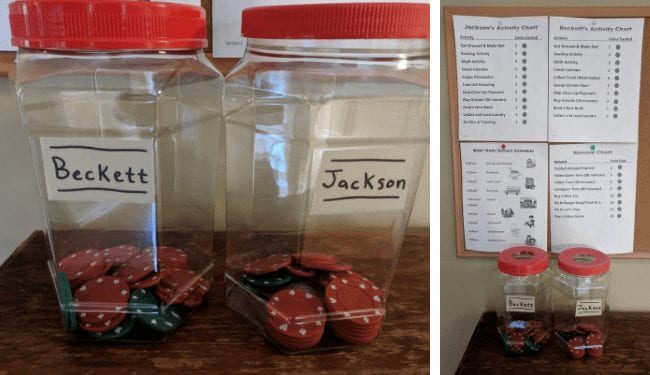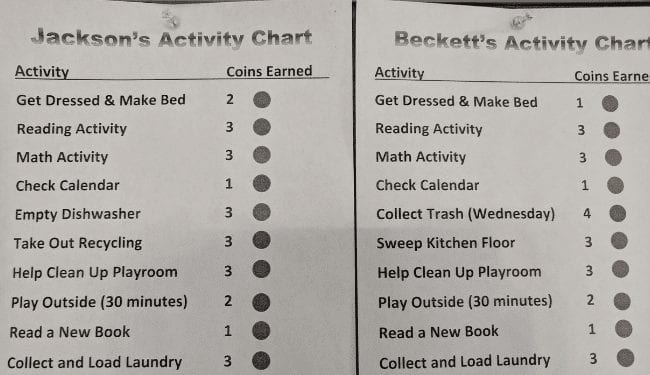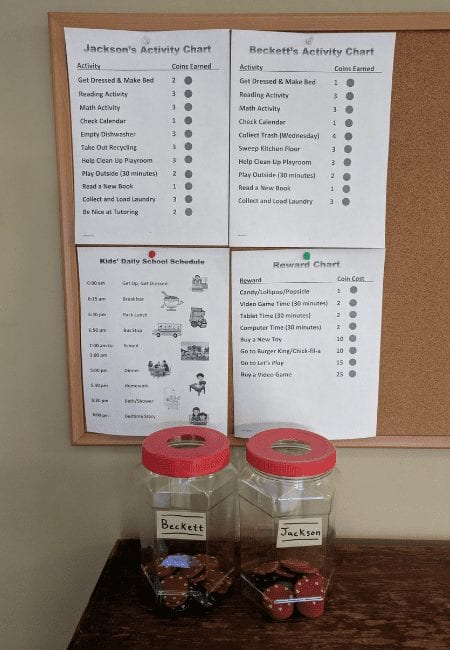Screen Time Solutions: The Coin System

Controlling your children’s time on their favorite electronics often comes up as a hot topic in any parenting conversation. At our house, our boys have their own computer, a couple of video game systems, and a tablet in addition to their low-tech plethora of toys. They are not wanting for activities to fill their time, but we struggled to find ways to limit their time with their high-tech toys. That is, until we instituted a coin system, which allows them to earn coins that they exchange for time on their electronics.
This has been a rousing success in our house, a system that I think translates well to any household because of its flexibility for both parents and kids.

The Coin System
Our first step was to decide how much time to allot and for how many coins. Since our boys are school age, we knew we would need it to be a longer chunk than what we might assign if they were both preschoolers. We gave them an exchange rate of 30 minutes screen time for two coins. We felt that a half-hour was enough time to satisfy any desire to play on their tablet or watch YouTube videos; if they wanted more time, they had to pay more coins. They also set their own timers so each child is aware of how much time he has on that device.
In order to earn these coins, the boys have to complete certain tasks. Each child has a list of chores and other activities they can do to earn coins as well as the number of coins they receive for each. Since our oldest’s chores are more labor intensive than his younger brother’s, he gets more coins.

We incentivize reading and other learning activities with coins as well; reading a book and completing certain school-related tasks also earns them coins. Because they are not allowed to use electronics during the school week, the boys save their coins for the weekends and, depending on their schedules for Saturday and Sunday, they often will use the majority of them.
More Than Just Screen Time
Additionally, they don’t have to save the coins for just screen time; they can use them for a piece of candy, a trip to a favorite restaurant, or, if they are especially disciplined, a toy. My youngest saved up enough coins to earn a new toy he had been admiring for some time. Our goal with this is to start the conversation about earning money for their work as well as what happens if they save versus spend. So far, they have seen the consequences of running out of coins, which usually results in a scramble for finding chores and other ways to earn more coins. Because they have to pay for their screen time, we already find that they are balancing that with time spent playing with their other toys, both inside and outside.

The boys also lose coins for misbehavior. If they dither about going to bed, I start docking coins for each minute it takes them to start their bedtime routine. If a child engages in undesirable behavior, such as talking back, then consequences can include the loss of coins.
For our oldest son, who is on the autism spectrum and has an easier time with visual cues, watching his coins go away when he misbehaves can be a great tool for limiting undesirable behaviors. For both children, we would try to incentivize positive behaviors and minimize negative ones by changing the number of coins they could earn for each activity. That gave us another avenue for communicating the types of behaviors we needed from our boys.
The Tools We Use
This system was pulled together with materials we had around the house: poker chips, a bulletin board, and a bank for holding coins. My husband created lists of tasks and their coin values for each child as well as a list of screen times and other desirables and their costs. We posted those on the bulletin board by the banks we assigned to each child. The poker chips serve as our coins, though you could use actual money if you find that more effective. For us, the poker chips worked best because they were larger and easier to see in the banks. The posted lists of chores and rewards serve as a reference of what they can do to earn more coins and what they can use them for, a constant visual reminder of the benefits of good behavior and doing their part at home.

This system has worked beautifully for us. We started it this summer when the boys were home with me and I needed a way to keep tabs on their activities. Now that they’re back in school, it also helps us limit their screen time and forces them to play in other ways, which makes the transition to dinner and homework much easier. As the boys get older, we can adapt this system to any changes in their interests or schedules. The flexibility of a system like this has yielded success for us and I think it could do the same in your home if you want to give a try.
Make It Work For You
If you need a way to limit screen time (or any behavior, really) for any child, regardless of age, this system can work for you. You can use real money or poker chips or whatever you would like as currency. You can assign any number of coins to a chore and you can vary the numbers based on the age of your children. The possibilities are endless!
If you decide to try this at your house, I hope you will share your system’s setup as well as its successes and failures with us here at Rocket City Mom.
You Might Also Like…
- Best Chore Chart for Kids of All Time
- Adventures In Potty Training & Despair
- The Beach Trip From Hades

Jennifer Kelly grew up in the Birmingham area, but migrated to Huntsville for graduate school and put down roots after meeting her husband, Jamie. In addition to being a mom to her two boys, she is a tennis ninja, trivia nerd, freelance editor, and aspiring writer. You can visit her at The Sir Barton Project, a blog about her upcoming book.





